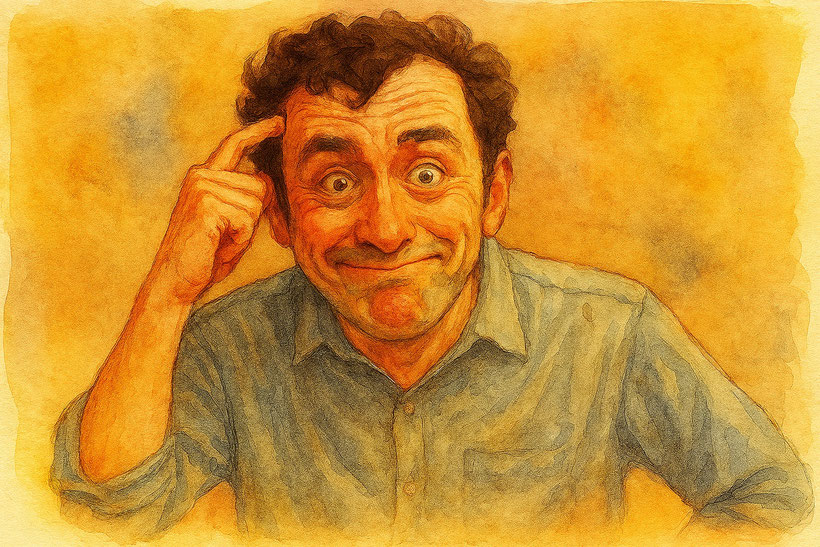So, you’ve discovered the Alexander Technique. You’re reading books or working with a teacher, and you’re diligently practicing your Directions: "Let the neck be free, to let the head go forward and up, to let the back lengthen and widen..." It’s exciting! You’re becoming more aware of your habits, and you’re starting to feel a new sense of ease and lightness. But then, something happens. You find yourself in a stressful work meeting, or you're rushing to get dinner on the table, and a thought pops into your head: "Am I using my Alexander Technique right now? Is my neck free? Oh no, I think I’m slumping! I need to Direct! Why can't I maintain my Directions all the time?". Suddenly, what was meant to be a tool for ease has become a source of mental clutter and performance anxiety. If this sounds familiar, you’re not alone. Welcome to the very common trap of overthinking the Alexander Technique.
It's a Way of Being, Not a Checklist
The fundamental point we often miss is this, the Alexander Technique is not a set of rules to be constantly monitored. It’s not a posture you “hold.” Fundamentally, it is an experiential practice and a way of being in the world.
Think of it like learning to ride a bike. At first, you have to think about everything, balancing, pedalling, steering, braking. Your mind is full of instructions. But with practice, the process becomes integrated. You don't think, "Now I must shift my weight 2 inches to the left to balance." You just ride the bike. The skill becomes a part of you.
The Alexander Technique is the same. The conscious, verbal Directions we learn in lessons and practice in quiet moments are the training wheels. They are the means, not the end. The end is to return to our natural, integrated state of poise and coordination, where we don't have to think about it, we just inhabit it.

Why Constant Thinking is Counterproductive
F.M. Alexander himself was wary of what he called "end-gaining", focusing so intensely on a goal that you create more tension in the process, a process that you've lost sight of. If your goal is to "have good Alexander Technique all the time," and you use constant mental chatter to try and achieve it, you are end-gaining. You're creating a new layer of interference, the very thing the Technique aims to remove.
Trying to consciously direct and inhibit yourself 24/7 is an unrealistic and exhausting expectation. We're only human, after all! Our brains are evolved to automate learned skills so we can focus on living our lives: having conversations, being creative, solving problems, and enjoying the moment.
So, What's the Role of Conscious Thought?
This doesn't mean we throw out conscious practice. It’s essential! The key is to see it as a punctual, mindful activity, not a continuous one.
Think of it as hitting the "refresh" button. Reset and renew. You can consciously decide to:
- Pause for a moment before starting a new activity (like sitting down at your computer or picking up a cup of tea) and simply notice your state without judgment. Neutral observation is an invaluable skill.
- Practice a brief Constructive Rest (Semi-Supine) or a moment of quiet attention to reconnect with the Directions.
- Use your Alexander thinking as a tool to navigate a known trigger, like noticing the tension in your shoulders during your commute and choosing to release it.
In these moments, you are consciously applying the principles. But once you’ve hit that refresh button, you let it go. You return to your activity, trusting that the work you’ve done has had an effect. You allow the new, easier coordination to be in the background, supporting you while you focus on the task at hand. It's a constructive interference, but not a way to be 24/7. When things are going well, why distract yourself with an artificial overlay?
Shifting from "Doing" to "Allowing"
The real mojo happens when we shift from doing the Technique to allowing it. It's the difference between:
- Doing: "I must pull my head up and make my back straight." (This creates tension).
- Allowing: "I can inhibit my habit of slumping and allow my head to be poised on top of my spine." (This creates release).
This is a subtle but profound shift from effort to permission. It’s about creating the conditions for your natural poise to emerge, not forcing yourself into a shape you think is "right."
Be Kind to Yourself
If you catch yourself overthinking your Alexander Technique, take it as a sign of your commitment, not your failure. Gently remind yourself:
- It's a practice, not a perfect. There is no finish line.
- Use your thinking as a tool, not a taskmaster. Consciously Direct when it’s helpful, then let it go.
- Trust the process. The work you do in your lessons and your quiet practice moments is rewiring your sensory awareness and neuromuscular habits. It is working, even when you're not thinking about it.
The next time you feel the mental checklist starting, or worry about whether you're doing the Alexander Technique correctly, take a moment. Inhibit the urge to "get it right." Instead, just notice the ground supporting you, the space around you, and the fact that you are a human being, learning, growing, and wonderfully imperfect. That, in itself, is a beautiful application of the Alexander Technique.
Write a comment